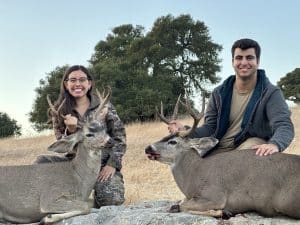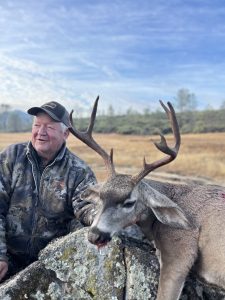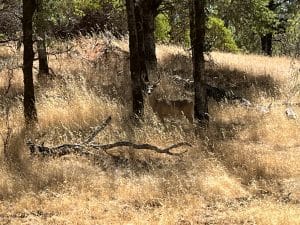California’s rugged coastal ranges and dense forests offer some of the most challenging and rewarding hunting experiences for blacktail deer enthusiasts. These elusive animals test even seasoned hunters with their keen senses and unpredictable behavior. Whether you’re a first-time hunter or looking to refine your skills, mastering blacktail deer hunting requires understanding their unique habits, choosing the right equipment, and employing proven strategies that work in California’s diverse terrain.
This comprehensive guide covers everything you need to know about hunting blacktail deer in the Golden State—from understanding their behavior patterns to preparing your harvest. You’ll discover the best hunting locations, essential gear recommendations, and time-tested tactics that consistently produce results.
Understanding Black Tail Deer Behavior and Habitat 
Physical Characteristics and Subspecies
Black tail deer are smaller than their white-tailed cousins, with mature bucks typically weighing 130-200 pounds and does ranging from 90-130 pounds. Their distinctive black-tipped tails and gray-brown coats help them blend seamlessly into California’s coastal brush and oak woodlands.
Two subspecies inhabit California: the Columbian black tail deer in the northern regions and the California mule deer (black tail subspecies) throughout the central and southern coastal areas. Both share similar behavioral patterns but may vary slightly in size and habitat preferences.
Habitat Preferences
Black tail deer thrive in California’s mixed terrain, favoring areas that provide:
- Dense cover: Thick brush, oak groves, and chaparral offer protection from predators and hunters
- Edge habitats: Transitions between forest and meadow provide both food and security
- Water sources: Streams, springs, and water holes are essential, especially during dry seasons
- Elevation variety: These deer move seasonally between higher summer ranges and lower winter areas
Daily and Seasonal Movement Patterns
Understanding when and where black tail deer move is crucial for hunting success. These animals are most active during dawn and dusk, making early morning and late afternoon prime hunting times.
During summer months, deer seek cooler, shaded areas during midday heat. They often bed down in thick cover on north-facing slopes or dense brush. As temperatures drop in fall and winter, they become more active throughout the day.
Seasonal patterns include:
- Spring: Deer move to higher elevations seeking fresh vegetation
- Summer: They remain in cooler, higher areas with adequate water
- Fall: Rutting season increases movement and makes bucks more aggressive
- Winter: Deer descend to lower elevations to escape snow and find food
Essential Gear for Black Tail Deer Hunting 
Firearms and Ammunition
Choosing the right weapon depends on your hunting style and terrain. Popular choices include:
Rifles: For long-range shots in open country, consider calibers like .270 Winchester, .30-06 Springfield, or .308 Winchester. These provide excellent stopping power and accuracy at a distance.
Bow hunting: Compound bows offer stealth advantages in thick brush. Choose arrows with broadheads designed for maximum penetration and blood trails.
Shotguns: In dense cover areas, slug-loaded shotguns can be effective for close-range encounters.
Optics and Navigation
Quality optics can make the difference between success and disappointment:
- Binoculars: 8×42 or 10×42 models provide excellent light gathering for dawn/dusk hunting
- Rifle scopes: Variable power scopes (3-9×40) offer versatility for various shooting distances
- Rangefinders: Essential for accurate shot placement, especially in California’s varied terrain
Don’t forget navigation tools like GPS units, topographic maps, and a compass. California’s vast wilderness areas can be disorienting, and getting lost poses serious safety risks.
Clothing and Camouflage
Black tail deer have exceptional eyesight and hearing. Your clothing strategy should prioritize:
- Camouflage patterns: Choose patterns that match your hunting area’s vegetation
- Scent control: Use scent-blocking clothing and sprays
- Weather protection: California’s coastal weather can change rapidly
- Safety orange: Required in many hunting areas—check local regulations
Where to Hunt: Top Locations in California 
Northern California Hot Spots
Mendocino National Forest: Known for excellent blacktail populations, particularly in the Elk Mountain and Snow Mountain areas. The varied terrain offers both challenging stalking opportunities and stand hunting locations.
Humboldt County: Dense redwood forests and coastal ranges provide prime habitat. Private ranches often offer guided hunts with high success rates.
Shasta-Trinity National Forest: Offers diverse hunting opportunities from thick timber to open meadows. The Trinity Alps region produces trophy-quality bucks.
Central California Destinations
Los Padres National Forest: Stretching along the coast, this area offers excellent blacktail hunting in the Santa Lucia Mountains. The Big Sur region is particularly productive.
Monterey County: Private ranches and public lands provide varied hunting experiences. The Santa Lucia Highlands produce quality deer.
Southern California Options
Cleveland National Forest: Despite urban proximity, this area maintains healthy deer populations. The Palomar Mountain region offers excellent opportunities.
Los Angeles County: Several hunting zones within driving distance of major population centers provide accessible hunting opportunities.
Public vs. Private Land Considerations
Public lands offer affordable hunting opportunities but require more scouting and may have higher hunter pressure. Private ranches often provide guided experiences with higher success rates but come at a premium price.
Research land access rules carefully. Some areas require special permits or have restricted access during certain seasons.
Tactics and Strategies for a Successful Hunt
Spot and Stalk Method
This active hunting style works well in California’s open areas and brush country. The key is glassing large areas from vantage points, then planning careful stalks to within shooting range.
Glassing techniques:
- Use binoculars systematically to scan the terrain
- Focus on transition zones between habitat types
- Look for movement, not whole animals
- Glass during peak activity periods
Stalking strategies:
- Plan your route carefully, using terrain features for concealment
- Move slowly and deliberately
- Use wind direction to your advantage
- Be prepared for quick shots when opportunities arise
Stand Hunting
Setting up in strategic locations and waiting for deer to come to you can be highly effective, especially during rutting season.
Stand placement considerations:
- Position stands near water sources during dry periods
- Focus on travel corridors between bedding and feeding areas
- Consider wind direction for scent control
- Ensure safe shooting lanes and backdrop
Tracking and Sign Reading
California’s diverse soil conditions and vegetation create excellent tracking opportunities after rain or in soft ground.
Key signs to look for:
- Fresh tracks in soft earth or sand
- Rubs on trees and bushes (especially during the rut)
- Scrapes and droppings
- Bedding areas in thick cover
Calling Techniques
While not as responsive as other deer species, black tail deer can be called during rutting season. Grunt calls and rattling antlers can attract curious bucks.
Use calls sparingly and only when you have good concealment. Black tail deer are notoriously wary and will quickly leave the area if they detect something amiss.
Licensing, Regulations, and Safety Tips
California Hunting License Requirements
All hunters must possess valid California hunting licenses and appropriate tags. Requirements include:
- Basic hunting license: Required for all hunters over 16
- Deer tag: Specific to hunting zones and seasons
- Hunter safety certification: Mandatory for all hunters born after 1957
Zone and Season Information
California divides deer hunting into specific zones with varying seasons and bag limits. Research your chosen area’s regulations carefully, as they change annually.
Key regulation points:
- Check the exact season dates for your hunting zone
- Understand bag limits and antler restrictions
- Verify weapon restrictions in your area
- Confirm the required hunter orange requirements
Safety Considerations
Black tail deer hunting often occurs in remote, rugged terrain. Essential safety practices include:
- Communication: Inform someone of your hunting plans and expected return
- Navigation: Carry GPS units and backup navigation tools
- Weather awareness: California’s coastal weather can change rapidly
- First aid: Carry comprehensive first aid supplies
- Emergency shelter: Be prepared for unexpected overnight stays
Hunter Ethics and Fair Chase
Ethical hunting practices ensure sustainable deer populations and a positive hunter image. Follow fair chase principles:
- Take only shots you’re confident you can make cleanly
- Track wounded animals diligently
- Respect private property and other hunters
- Follow all regulations and bag limits
Preparing and Cooking Your Harvest
Field Dressing and Processing
Proper field care ensures quality meat and prevents spoilage. Key steps include:
Immediate field dressing:
- Remove internal organs as soon as possible
- Cool the carcass quickly
- Protect meat from dirt and debris
- Transport to the processing facility promptly
Aging and processing:
- Age meat properly for improved tenderness
- Consider professional processing for best results
- Package meat properly for long-term storage
Cooking Black Tail Venison
Black tail deer meat is lean and flavorful but requires careful cooking to prevent drying. Popular preparation methods include:
Grilling: Steaks and chops work well with quick, high-heat cooking
Roasting: Larger cuts benefit from slow roasting with added moisture
Slow cooking: Tougher cuts become tender in stews and braises
Jerky making: Preserve your harvest for long-term enjoyment
Ensuring Future Hunting Success Through Conservation
Black tail deer hunting in California represents more than just pursuing game—it’s participating in wildlife conservation and maintaining hunting traditions for future generations. Your license fees and tag purchases directly fund habitat improvement, wildlife research, and conservation programs.
Successful hunters understand that ethical practices, respect for wildlife, and habitat stewardship ensure hunting opportunities continue. By following regulations, practicing safe hunting techniques, and supporting conservation efforts, you contribute to healthy deer populations and sustainable hunting practices.
Ready to plan your next black tail deer hunt? Start by researching hunting zones, obtaining proper licenses, and scouting potential hunting areas. Remember that consistent success comes from understanding deer behavior, using appropriate equipment, and employing proven hunting strategies.
The challenge of hunting California’s black tail deer rewards patient, skilled hunters with unforgettable experiences and quality meat for the table. Your next trophy buck awaits in California’s diverse hunting landscapes.

